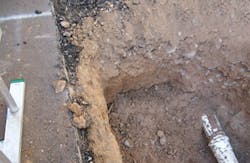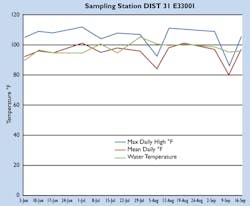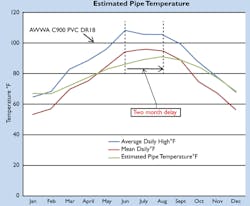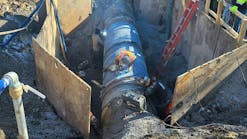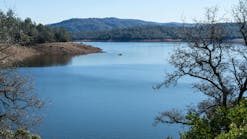Can Pipelines Withstand the Desert Heat?
Since the 1950s, PVC pipe has been widely used in the US for water distribution. However, unacceptable failure rates when subjected to high temperatures in Arizona meant local utilities discontinued the use of the material. New research has since addressed fatigue and thermal stability of PVC water pipe in hot weather climates. This article looks at the findings.
By Joseph A. Kurrus
PVC pipe was first used in drinking water systems in 1936 in Germany. Most of the pipe installed in that era is reportedly still in service. The first usage in North America was in 1949, and the material was first used for water distribution in the USA in 1952. In 1963, the US Dept of Commerce issued the first specification for PVC pressure pipe.
Its widespread use began in the early 1970s. Some early pipe installations experienced defects caused by exposure to ultraviolet light, when pipe was stored outside and unprotected from the sun. Other installations experienced failures due to improper trench bedding and careless installation of the pipe. In 1975, AWWA published its standard C900 for PVC water pressure pipe. Ten years later and records show that 750,000 miles of rural PVC water pipe had been installed in the US. In 1981, AWWA approved the second edition of AWWA C900.
The usage of PVC pipe has steadily increased and in 2004, PVC pipe made up a 78% share of water distribution pipe in North America. However, PVC pipe material's reputation has been tarnished by manufacturing defects and installation practices not conducive to pipe longevity. As a result industry lawsuits were filed.
One such lawsuit claimed cost cutting measures by a major pipe manufacturer led to substandard pipe material that did not meet ASTM specifications. The manufacturer offered an extended 50-year warranty on any pipe claimed to be defective.
In November 2013 a federal jury in California found a pipe manufacturer liable for making false claims about PVC water pipe it sold to states and municipalities over the course of nearly a decade. As the pipes are used extensively in drinking water, irrigation and other public systems, the jury's verdict opens the company to potentially billions of dollars in damages, with an exact amount to be determined in a separate trial.
Case Study in Arizona
An example of substandard pipe longevity is documented in a local subdivision in a metro Phoenix municipality. This small subdivision had approximately 8000 LF of 6" and 8" Class 160 (SDR 26), thin wall, irrigation PVC water pipe (ASTM D2241) installed in 1982. From 2007 until 2012 there have been ten leaks from the failed pipe resulting in water main repairs.
Observations during repair of the leaks indicated pipe bedding and backfill material to be native unaltered material with large rocks and boulders. In the failed pipe, the cracks were typically located where large rocks and boulders had punctured or pierced the pipe.
To investigate the pipe failure mechanism a pressure monitor was installed in the distribution system. The data retrieve indicated the pressure varied from about 72 psi to 86 psi over approximately one week time duration. The zonal pressure according to normal operations at that location should have been about 79 psi, indicating the system was operating within the anticipated range during the monitoring.
Upon de-rating Class 160 irrigation pipe (pressure rating 160 psi) for temperature according to AWWA C-900 (62% of the specified working pressure @ 100° F) the pipe would be rated for 99 psi working pressure. Therefore the safety factor is only 1.15 for these conditions.
A 10' section of 6" PVC pipe from this sub-division was removed and tested using ASTM test procedures. The photograph on the previous page shows this pipe section prior to removal from the ground. The photograph shows the boulders and rock in the backfill and bedding confirming the substandard installation.
Laboratory test results were conducted at VINYLTECH in October 2012 on test coupons taken from this pipe section.The 30 year old pipe passed all the tests! The test procedure calls for 40% deflection, however defects were not observed at 40% deflection during the test so it was decided to continue the test in an attempt to reach the failure point of the specimen. At 80% deflection there was permanent deformation but no observed cracks or other signs of failure.
In conclusion, the pipe failures of the Class 160 (SDR 26) PVC water main in the subdivision appear to be the result of improper bedding and backfill conditions coupled with the low safety factor for internal pressure. Since the pipe section passed all new pipe ASTM tests, fatigue and temperature do not appear to be contributing factors to the failures observed.
Fatigue failure mechanism
Cyclic loading of plastic pipe is a known fatigue risk factor that can lead to failure. Design allowances are needed to compensate for known cycling and transients. In order to assess the effects of fatigue on the system, pressure monitoring was conducted, evaluated, and the results used to determine design life based upon fatigue.
Pressure monitoring of the water system was performed for two of the lower pressure zones that contain the oldest infrastructure. Pressure monitoring was also performed for the case study. This data was obtained using a Global Water Model PL200-H Hydrant Pressure Logger. This instrument has an accuracy of +/- 1% full scale and can be adjusted to sample as often as ten times per second. It is capable of storing nearly 82,000 data points.
Two different approaches for determination of design life (Uni-Bell and Mahaffay) support a design life of at least 50 years for AWWA C900 PVC pipe. Based upon the pressure monitoring described and an assumed DR 18 pipe, the empirical formula suggests a life expectancy of 587 and 720 years for PVC water pipe in the two locations monitored. The results confirm that the fatigue service life far exceeds the design life expectancy of 50 years for DR 18 pipe.
Thermal Stability PVC Pipe
PVC pipe material has thermoplastic properties, which cause its physical properties to change with temperature variations.
The AWWA C900 published performance, dimensions and pressure ratings are applicable for operating temperatures up to 73°F. In recognition of this, AWWA C900 requires the working pressure to be de-rated at elevated operating temperatures.
The de-rating factors are 88% for 80°F and 62% for 100°F. For AWWA C900, DR 18 pipe, this converts to working pressures of 207 psi at 80° F and 146 psi at 100° F. For DR 25 pipe the ratings are 145 psi and 102 psi respectively. Refer to Table 1 for a summary of this information.
So the question becomes, what is the temperature of the pipe? Several studies have explored this issue and concluded that the pipe temperature, soil temperature (where the pipe is located) and water temperature are all about the same.
One way to determine the soil temperature would be to project the estimated temperature gradient from the surface temperature to the pipe depth. In a soil temperature study Halverson showed that the maximum summer temperature gradient was -6.6 °F per foot of soil depth under unshaded asphalt. Using these temperature gradients the soil temperature at the typical pipe depth of three feet would be around 20°F less than the surface temperature. So if the temperature near the surface were 110°F the expected pipe temperature would be 90°F.
Another study, by Blokker developed a soil temperature model for predicting water temperature in drinking water distribution systems. The results showed that water temperatures inside the pipe reach the temperature of the surrounding soil. It also showed that the pipe material temperature (including PVC) approximates the same value and that the temperature at the tap can be assumed to equal the soil temperature around the mains.
Results showed that the soil temperature fluctuates less than atmospheric temperature throughout the day, but does correlate seasonally. Daily summertime soil temperatures were generally about 10°F less than atmospheric.
Temperature data
According to meteorological data for metro Phoenix, the average daytime high temperature during the hottest month of the year (July) is 107°F while the mean temperature for the same 24 hour period is 86° F. The historical hottest 24 hour period on record is currently 105°F. Results from Blokker and Halverson suggest that pipe material temperature would be not be expected to exceed about 95°F on the hottest day.
To validate this expectation, temperature data from 50 sampling stations was collected throughout calendar year 2013 and analyzed. Each sampling station is sampled approximately three times per month throughout the year. Calendar year 2013 was the hottest summer on record in Phoenix according to the National Weather Service, which makes it an excellent year to use for determinations about maximum expected pipe temperatures.
The data also shows that once the maximum temperature of both the ground and atmosphere are reached they begin cooling at about the same time, although the rate of decline is less for the ground. This occurred in September thru February for the ground and September thru January for the atmosphere. The heating for the ground began in March while atmosphere began heating in February. So there appears to be a one month lag in the ground responding to the warming atmospheric conditions.
This data therefore supports the conclusion that ground temperature correlates seasonally with atmospheric temperature, but there can also be a lag time of one to two months in such correlation. It also supports the conclusion that the ground temperature remains below the mean daily temperature during the summertime.
Expected pipe temperature
Examination of the data reveals that the maximum expected pipe temperature on average would be about 91°F in the summertime. However closer examination of the data reveals that at some sampling stations the water temperature may exceed 100°F for brief periods of time.
For example at the sampling station with the highest recorded temperatures (DIST 31E33001) the water temperature was 105°F on July 29th, while the maximum temperature that day was 107°F and the mean daily was 96°F. This contradicts the conclusion that the soil temperature will remain below the mean daily temperature during the summer months. One possible explanation of this would be the sampling procedure failing to flush the pipe long enough to reach the stable temperature in the waterline.
There were only seven occurrences (1.5%) out of all summer samples taken where the sample water exceeded 100°F. Outside of these anomalies, it appears reasonable to design for a maximum pipe temperature of 100°F in the metro Phoenix area and other areas with similar conditions.
Recommendations
Based upon the above information it appears to be safe to use PVC C900 in a desert climate such as metro Phoenix, AZ.
- The designer should take into consideration expected pipe pressures, by monitoring pressure at the locations where the pipe is to be installed, and perform a fatigue analysis.
- If temperature of the soil or pipe is available, it should be taken into account, but as long as the pipe is 3' or deeper it is reasonably safe to assume that it will not exceed 100°F.
- The pipe must be installed according to recommended guidelines for proper bedding and backfill.
Proper installation of underground pipe is critical to its longevity. This is especially true of PVC pipe and other flexible pipe, because of their susceptibility to installation deficiencies and reliance on bedding and backfill as a support mechanism. There are a number references available that provide information about installation, including those by the various manufacturer's of the pipe.
To ensure proper installation, a specific trench detail for the conditions that are expected should be prepared by the design engineer. This would take into consideration depth of burial, soil type, trench width, bedding and backfill materials, compaction, loading, etc.
Joseph A. Kurrus, PE is Engineering Supervisor for the City of Peoria in Arizona. For more information, email: [email protected].
More Water & WasteWater International Archives Issue Articles
